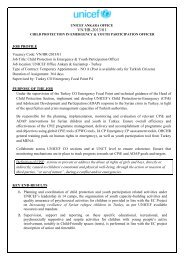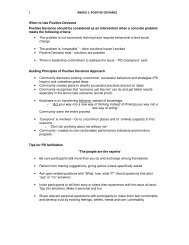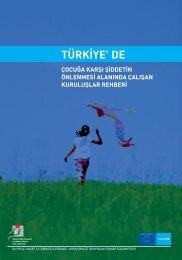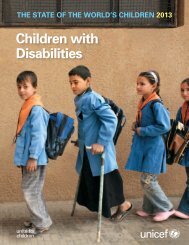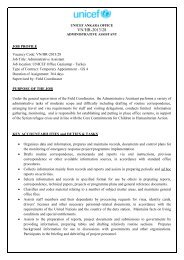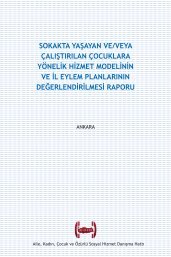A Policy Framework for Early Childhood Development
A Policy Framework for Early Childhood Development
A Policy Framework for Early Childhood Development
Create successful ePaper yourself
Turn your PDF publications into a flip-book with our unique Google optimized e-Paper software.
A POLICY FRAMEWORK FOR EARLY<br />
CHILDHOOD DEVELOPMENT AND ITS<br />
APPLICATION TO TURKEY<br />
March 2011<br />
Istanbul<br />
Cristobal Ridao-Cano Human <strong>Development</strong> Sector Coordinator, World Bank<br />
Meltem A. Aran Economist, World Bank
Overview<br />
1. The challenge: <strong>Childhood</strong> risks and inequalities in Turkey<br />
2. A framework <strong>for</strong> ECD programs and policies<br />
3. ECD programs and policies in Turkey<br />
4. Some preliminary reflections
<strong>Childhood</strong> risks and inequalities in Turkey
Hypothesized relations between poverty, stunting, child<br />
development, and school achievement<br />
Source : Walker S, Wachs T, Meeks Gardner J, et al. 2007. Child development: risk factors<br />
<strong>for</strong> adverse outcomes in developing countries LANCET 145-157.
<strong>Childhood</strong> risks and inequalities<br />
<strong>Early</strong> divergence in exposure to these risk factors by<br />
initial circumstances of children in Turkey today.<br />
We aim to:<br />
identify the extent to which “circumstances” are important in<br />
shaping children’s outcomes today, and there<strong>for</strong>e adult<br />
outcomes of the future; and how this has changed in recent<br />
times (2003-2008)
Circumstance definitions<br />
The 7 circumstance variables selected <strong>for</strong> the analysis are the following:<br />
1. Location of childhood: Urban or Rural (2 categories)<br />
2. Region of childhood: West, South, Central, North and East (5 categories)<br />
3. Mother’s Education: No <strong>for</strong>mal education, primary, secondary, higher education (4<br />
categories)<br />
4. Father’s Education: No <strong>for</strong>mal education, primary, secondary, higher education(4<br />
categories)<br />
5. Turkish mother tongue: Turkish, non-Turkish mother tongue spoken at home (2<br />
categories)<br />
6. Household wealth (asset) quintiles : 5 quintiles (5 categories)<br />
7. Gender of the child (2 categories)<br />
<br />
<br />
Disadvantaged: Rural location, primary or less than primary educational attainment of<br />
parents, non-Turkish mother tongue<br />
Advantaged: urban location, higher education of father and secondary education of mother,<br />
Turkish mother tongue.
Probability of not receiving care<br />
Health Care Utilization during Pregnancy and Birth<br />
70%<br />
60%<br />
50%<br />
40%<br />
30%<br />
20%<br />
10%<br />
0%<br />
Significant inequalities persists in access to health care. However, healthrelated<br />
risks have decreased <strong>for</strong> antenatal care and birth, particularly<br />
among disadvantaged children.<br />
64%<br />
54%<br />
66%<br />
Least<br />
Advantaged<br />
26%<br />
25% 24%<br />
Average<br />
7%<br />
2% 3%<br />
Most<br />
Advantaged<br />
61%<br />
47%<br />
43%<br />
Least<br />
Advantaged<br />
27%<br />
14%<br />
12%<br />
Average<br />
2003 2008<br />
10%<br />
6% 5%<br />
Most<br />
Advantaged<br />
Mother has not<br />
received antenatal<br />
care during pregnancy<br />
Birth not at public or<br />
private health facility<br />
Birth not attended by<br />
skilled health staff<br />
Source data:<br />
TDHS 2003-2008
.1 .2 .3 .4<br />
0<br />
Kernel density<br />
.1 .2 .3 .4<br />
0<br />
Malnutrition Indicators (Stunting)<br />
•Prevalence of stunting (height-<strong>for</strong>-age measure below 2 standard deviations of the<br />
international median) was about 13.2 percent of children in the 0-4 year age group in Turkey in<br />
2003 and came down slightly to 11.2 percent in 2008.<br />
•The variation in stunting prevalence across circumstance groups is wide. Among the most<br />
“advantaged” group of children in the sample, the prevalence is 3.9 percent, while in the<br />
“disadvantaged” group this level is 28.7 percent as of 2008.<br />
Height-<strong>for</strong>-Age Measure (2003)<br />
(indicates stunting)<br />
Height-<strong>for</strong>-Age Measure (2008)<br />
(indicates stunting)<br />
-6 -4 -2 0 2 4<br />
Standard deviations from mean<br />
Source data: Turkey DHS 2003<br />
Least advantaged group<br />
Most advantaged group<br />
-5 0 5<br />
Standard deviations from mean<br />
Source data: Turkey DHS 2008<br />
Least advantaged group<br />
Most advantaged group
% of children in<br />
quintile (ages 0-4)<br />
Enrolment in center-based childcare and<br />
preschool services is highliy regressive<br />
Enrolment in center-based ECE services<br />
(<strong>for</strong> Ages 0-4), by income quintile<br />
20.0%<br />
15.0%<br />
10.0%<br />
5.0%<br />
0.0%<br />
0.8% 0.7% 0.8%<br />
Quint 1<br />
(poorest)<br />
5.8%<br />
16.5%<br />
Quint 2 Quint 3 Quint 4 Quint 5<br />
Per capita income quintiles<br />
Enrolment in preschool,<br />
childcare at center-based<br />
services or daycare<br />
Source data: Turkey EU SILC 2007
Hours per week<br />
Number of hours spent in center based childcare &<br />
preschool minimal <strong>for</strong> poorer quintiles<br />
30.0<br />
25.0<br />
20.0<br />
15.0<br />
10.0<br />
5.0<br />
-<br />
Mean number of hours of childcare per week<br />
(<strong>for</strong> children ages 0-4),<br />
by per capita income quintile<br />
4.0<br />
5.1<br />
3.8<br />
1.0<br />
1.8 11.9<br />
0.6 0.4 0.6<br />
4.5<br />
Quint 1 Quint 2 Quint 3 Quint 4 Quint 5<br />
(poorest)<br />
Per capita income quintiles<br />
Childcare by grandparent or<br />
familiy member other than<br />
parents<br />
Childcare by professional<br />
Childcare at center-based<br />
services or daycare<br />
Preschool<br />
Source data: Turkey EU SILC 2007
Exposure to Multiple Risk Factors<br />
4 biological and psychosocial risks: (i) Stunting , (ii) Iron deficiency anemia<br />
(iii) Low cognitive stimulation: Mother with no <strong>for</strong>mal education (iv) Low<br />
90% cognitive stimulation: No access to preschool or kindergarten<br />
80%<br />
80%<br />
70%<br />
60%<br />
50%<br />
40%<br />
30%<br />
20%<br />
10%<br />
0%<br />
41%<br />
28%<br />
Exposure to at least<br />
1 risk factor<br />
20%<br />
12%<br />
5%<br />
0%<br />
3%<br />
0%<br />
Exposure to at least<br />
2 risk factors<br />
Least Advantaged<br />
Average<br />
Most Advantaged<br />
Exposure to at least<br />
3 risk factors
0.00 0.25 0.50 0.75 1.00<br />
Survival rate<br />
0.00 0.25 0.50 0.75 1.00<br />
The differences across opportunity groups be<strong>for</strong>e<br />
school are rein<strong>for</strong>ced in the school system<br />
•Survival in basic and secondary education vary by opportunity group .<br />
•The breaking points in enrolments are at grade 5 and grade 8 <strong>for</strong> the<br />
disadvantaged group in both of these years.<br />
•However, up to grade 8, the survival rate of the disadvantaged group is<br />
consistently higher in 2008 when compared to 2003.<br />
Kaplan-Meier Survival Rates in School Enrolments (2003)<br />
(by advantage group)<br />
Kaplan-Meier Survival Rates in School Enrolments (2008)<br />
(by advantage group)<br />
0 1 2 3 4 5 6 7 8 9 10 11 12<br />
Note: Includes sample (age>=10 & age=10 & age
0.00 0.25 0.50 0.75 1.00<br />
Survival rate<br />
0.00 0.25 0.50 0.75 1.00<br />
Survival rates <strong>for</strong> girls and boys in most<br />
disadvantaged group<br />
•Improvement in survival rates <strong>for</strong> boys beyond grade 5, while <strong>for</strong> girls<br />
enrolments in the early years are higher, though after grade 5 the sharp<br />
decline in enrolments remain a problem.<br />
Kaplan-Meier Survival Rates in School Enrolments (2003)<br />
(by gender within disadvantaged group)<br />
Kaplan-Meier Survival Rates in School Enrolments (2008)<br />
(by gender within disadvantaged group)<br />
0 1 2 3 4 5 6 7 8 9 10 11 12<br />
Years of Educational Attainment<br />
Female in disadvantaged group<br />
Male in disadvantaged group<br />
Note: Includes sample (age>=10 & age=10 & age
A <strong>Framework</strong> <strong>for</strong> Benchmarking ECD Policies and<br />
Programs<br />
Step 1: Stock-take and classify ECD programs<br />
Step 2: Apply framework to evaluate the level of development ECD policies<br />
Step 3: Identify policy options to strengthen ECD policies and programs
Factors that affect ECD and life outcomes<br />
Context<br />
Macro (country)<br />
Micro (family)<br />
ECD Policies<br />
and programs<br />
Health, hygiene,<br />
and nutrition<br />
Education<br />
Poverty alleviation<br />
<strong>Early</strong><br />
<strong>Childhood</strong><br />
<strong>Development</strong><br />
Cognitive development<br />
Socio-emotional<br />
development<br />
Physical well-being<br />
and growth<br />
Life Outcomes<br />
Education<br />
Health<br />
Fertility<br />
Income<br />
Risky behaviors<br />
Source: Vegas and Santibáñez 2010
Programs that affect ECD<br />
Healthcare and hygiene<br />
Maternal/prenatal health<br />
Water and sanitation<br />
Healthcare prevention<br />
Mental Health<br />
Child<br />
Prenatal<br />
0-2<br />
3-4<br />
5-6<br />
Education<br />
Preschool (3-6)<br />
Care (0-3)<br />
Nutrition<br />
Food and supplements<br />
Mother(prenatal)<br />
Mother/Father/<br />
Caregiver<br />
Poverty alleviation<br />
Income transfers<br />
Maternity/paternity leave<br />
Female labor participation<br />
Home infrastructure
Impact of ECD interventions<br />
<br />
<br />
<br />
<br />
Interventions with nutritional components have positive effects on:<br />
growth and physical well-being<br />
cognitive development<br />
CCTs have positive impacts on:<br />
healthcare prevention and control<br />
cognitive and socioemotional development<br />
Preschool attendance has positive effects on:<br />
cognitive and socioemotional development<br />
the probability of continuing in school<br />
reduced participation in risky behaviors<br />
But the impact is greatest when interventions are multi-sectoral and<br />
integrated
Step 1: Stocktaking & classification<br />
of ECD programs<br />
9 Key Characteristics:<br />
i. Primary policy objective;<br />
ii. Brief description;<br />
iii. Focus area/intervention<br />
mechanism;<br />
iv. Coverage/access;<br />
v. Institutional arrangements;<br />
vi. Financing;<br />
vii. Service providers;<br />
viii. Quality assurance mechanisms;<br />
ix. Challenges <strong>for</strong> going to scale<br />
and improving service delivery.<br />
4 General Types of Programs:<br />
1. Sectoral<br />
2. Cross-sectoral<br />
3. Multi-sectoral<br />
4. Comprehensive
Complexity of Institutional Arrangements<br />
Coordinated<br />
interventions across<br />
multiple sectors<br />
Comprehensive<br />
Multi-<br />
Sectoral<br />
Cross-<br />
Sectoral<br />
Sectoral<br />
Single Sector<br />
Intervention Areas/Mechanisms<br />
Specific Sector w/ inputs<br />
from other sector<br />
Multiple sectors, specific<br />
programs <strong>for</strong> targeted or<br />
universal populations<br />
Comprehensive regular<br />
monitoring, some universal<br />
services, with tailored<br />
interventions
Step 2: Application of conceptual framework to<br />
evaluate the level of development ECD policies<br />
4 dimensions:<br />
4 levels of development:<br />
Enabling environment<br />
Degree of implementation<br />
Monitoring & quality assurance<br />
<strong>Policy</strong> focus<br />
• Legal framework<br />
• Coordination<br />
• Financing<br />
• Coverage<br />
• Programs<br />
• ECD in<strong>for</strong>mation<br />
• Quality<br />
standards &<br />
compliance<br />
• Sectoral to<br />
comprehensive<br />
Latent<br />
Emerging<br />
Established<br />
Mature
Step 3: Identification of policy options to<br />
strengthen ECD policies & programs<br />
<strong>Policy</strong> lessons can be drawn from countries that have<br />
achieved “established” and “mature” levels of<br />
development in the core dimensions of ECD<br />
Countries include Australia, England, New Zealand, and<br />
Sweden<br />
These lessons need to be adapted to local contexts in each<br />
country, to identify policy options
Key lessons from the selected OECD<br />
countries - General<br />
<br />
<br />
<br />
<br />
<br />
The establishment of the rights of children in law provides the foundation <strong>for</strong> an ECD<br />
system.<br />
Effective ECD systems do not work through government alone: stakeholders in ECD include<br />
all levels of government, research institutions, educators, not-<strong>for</strong>-profit organizations, private<br />
enterprises, and children and families.<br />
The best approach to developing an ECD system involves taking incremental steps, with<br />
emphasis on long-term policy design, establishing financial stability, and effective quality<br />
assurance mechanisms.<br />
Universal preschool services and a comprehensive social protection system are substantial<br />
components of ECD systems in the selected systems.<br />
Experiences from all four countries underlie the importance of establishing an institutional<br />
anchor to administer early childhood development policies and to foster and lead<br />
collaborative ef<strong>for</strong>ts amongst the different government agencies and stakeholders in the<br />
sector.
Key lessons from the selected OECD<br />
countries - Specific<br />
Substantial advancements in ECD have been made in England over the past 15<br />
years, demonstrating that significant strides can be made in a shorter period of<br />
time.<br />
<br />
<br />
Sweden is a standard <strong>for</strong> high-level ECD, with an extensive early childhood<br />
education system and a multi-tiered financial family policy that includes financial<br />
benefits, generous and equitable parental leave, and a needs-tested component to<br />
support families and children particular needs.<br />
Sweden illustrates some of the potential benefits of a decentralized approach to<br />
governance. Provision of early childhood services is the responsibility of local<br />
authorities, which are able to deliver services that are specific to local needs.
ECD programs and policies in Turkey
Overview of ECD programs in Turkey<br />
Child<br />
<strong>Development</strong><br />
Stage<br />
<strong>Early</strong> <strong>Childhood</strong> <strong>Development</strong> Goal Tools/Prograsm Examples of Actors in Turkey<br />
Prenatal – Birth Healthy antenatal development Parental support and education Pregnancy Monitoring - MOH<br />
Infancy<br />
(0-18 months)<br />
Toddler and posttoddler<br />
(18-36<br />
months)<br />
Healthy growth and nutrition<br />
Sensory learning (auditory and visual)<br />
Attachment to caregiver, Control of physical<br />
actions<br />
Breastfeeding and nutrition programs Growth monitoring - MOH<br />
Parent training programs<br />
Parent training (MONE)<br />
Nutrition Nutrition Growth monitoring (MOH)<br />
Coordination, language, ability to think, social<br />
skills advance<br />
Parent training<br />
Day Care Centers<br />
Community Driven Programs and<br />
Private Nurseries<br />
Parent training (MONE)<br />
Private day-care and nurseries<br />
(Private Sector)<br />
Private Community driven models<br />
(KEDV neighborhood nurseries)<br />
Preparation <strong>for</strong> school<br />
Programs linked to education and<br />
cognitive development<br />
Public preschools and kindergartens -<br />
<strong>for</strong> 5-6 year group (MONE)<br />
Preschool (Ages<br />
3-4-5)<br />
<strong>Early</strong> primary<br />
(Ages 6-7)<br />
Socialization Parent training programs Private preschools (Private Sector)<br />
Circle of peers and caregivers widens<br />
Health and nutrition remain important<br />
School preparedness programs<br />
Home-based MOCEP (<strong>for</strong> 6 year<br />
group only) (MONE & ACEV)<br />
SHÇEK Community Centers<br />
Transition to school Primary school Basic Education (MONE)
Toddler and posttoddler<br />
(18-36<br />
months)<br />
Prenatal<br />
Infancy (0-18<br />
months)<br />
Preschool<br />
(Months 36-72)<br />
While many different ECD model programs exist in<br />
Turkey, coverage of children remains low..<br />
Child <strong>Development</strong> Phase Intervention Coverage of Age Group<br />
Pregnancy Monitoring, MOH (2008)<br />
Immunizations - all complete, MoH (2008)<br />
~ 80%<br />
~ 90%<br />
Growth and Psycho-Social Monitoring - Family Doctors, MoH (2008)<br />
Parent training (0-6 year old), MONE (2009)<br />
Private day-care centers, nurseries and community driven models (2008)<br />
Parent training (0-6 year old), MONE (2009)<br />
< 10 %<br />
< 3 %<br />
< 1 %<br />
< 3%<br />
100 %<br />
coverage line<br />
Growth and Psycho-Social Monitoring, MoH (2008)<br />
SHÇEK Community Centers (2008)<br />
< 2%<br />
< 10 %<br />
Home-based MOCEP - <strong>for</strong> 6 year group only, MONE (2009)<br />
Private preschools (2008)<br />
< 3%<br />
~ 1%<br />
Public preschools & kindergartens - <strong>for</strong> 48-72 month group, MONE (2008)<br />
~ 39 %<br />
0% 20% 40% 60% 80% 100%
TL in 2008<br />
Low coverage is linked to low levels of public spending on<br />
ECD programs targeting children ages 0-6.<br />
Per Capita Social Expenditures by Age Group in Turkey (2008)<br />
(Central Government, Excluding Social Security Contributions)<br />
2.5<br />
2.0<br />
Education<br />
Social Protection<br />
Health<br />
1.5<br />
1.0<br />
0.5<br />
-<br />
0 5 10 15 20 25 30 35 40 45 50 55 60 65 70 75 80 85 90<br />
Age Group (0-90)<br />
Source: World Bank (2009) “Turkey Expanding Opportunities <strong>for</strong> the Next Generation”
Complexity of institutional arrangements<br />
Summary of ECD Programs in Turkey<br />
Coordinated<br />
interventions across<br />
multiple sectors<br />
Comprehensive<br />
Private<br />
Community<br />
Initiatives (KEDV)<br />
Family Training<br />
Programs<br />
Multi-<br />
Sectoral<br />
Public<br />
Preschools<br />
The Family<br />
Doctors Scheme<br />
Cross-<br />
Sectoral<br />
SHCEK<br />
Community<br />
Centers<br />
Sectoral<br />
Single sector<br />
Specific sector w/inputs<br />
from other sector<br />
Focus Areas- Mechanisms<br />
Multiple sectors, specific<br />
programs <strong>for</strong> targeted or<br />
universal populations<br />
Comprehensive regular<br />
monitoring. Some universal<br />
services, with tailored<br />
interventions
ECD <strong>Policy</strong> Dimensions and Levels of <strong>Development</strong><br />
in Turkey – Preliminary Findings<br />
ECD<br />
<strong>Policy</strong> Dimensions<br />
ENABLING ENVIRONMENT<br />
DEGREE OF IMPLEMENTATION<br />
MONITORING AND QUALITY<br />
ASSURANCE<br />
Variables<br />
Legal framework<br />
Coordination<br />
Financing<br />
Coverage<br />
Programs<br />
ECD in<strong>for</strong>mation<br />
Quality standards and compliance<br />
Level of <strong>Development</strong><br />
Established<br />
Emerging<br />
Emerging<br />
Emerging<br />
Established<br />
Established<br />
Emerging<br />
POLICY FOCUS<br />
ECD interventions (health, nutrition,<br />
education & child protection)<br />
Established
Strengthening ECD in Turkey: Some Preliminary<br />
Reflections<br />
<br />
<br />
<br />
<br />
Consider developing a comprehensive ECD strategy that integrates and coordinates<br />
interventions in different areas, providing a clear organizational framework <strong>for</strong> ECD.<br />
<br />
define roles and responsibilities of public agencies involved in ECD (including the coordinating<br />
body) and also NGOs and the private sector, which plays an important role.<br />
Increase funding <strong>for</strong> ECD to expand coverage, particularly of disadvantaged children.<br />
Set clear standards <strong>for</strong> ECD that are linked directly to child development and learning<br />
(rather than only infrastructure inputs), and strengthen the quality assurance system to<br />
monitor and ensure compliance with these standards.<br />
Facilitate private sector and community-based expansion <strong>for</strong> ECD by closely regulating<br />
and possibly co-financing these initiatives.
TEŞEKKÜR EDERİZ<br />
March 2011<br />
cridaocano@worldbank.org,<br />
meltem.aran@economics.ox.ac.uk,
Appendix
Determinants of access to health care<br />
Over time, circumtstance variablles have become less strong as correlates or<br />
determinants of access to health care<br />
Probability of Birth not being attended by skilled staff<br />
Gender of child: Female<br />
Asset quintile 4<br />
Asset quintile 3<br />
Asset quintile 2<br />
Asset quintile 1<br />
# of children: 5 or more<br />
# of children: 3-4<br />
Mother Tongue: Non-Turkish<br />
Father’s Educ: Secondary<br />
Father’s Educ: Primary<br />
2003<br />
2008<br />
Father’s Educ: No education<br />
Mother’s Educ: Secondary<br />
Mother’s Educ: Primary<br />
Mother’s Educ: No education<br />
Location: Rural<br />
0 0.05 0.1 0.15 0.2 0.25<br />
Partial correlation coefficient in Probit regression
Determinants of Stunting<br />
As of 2008, asset quintiles (wealth) and mother tongue remain theonly significant determinants of<br />
stunting. Father’s educational attainment, gender of chlid and rural loction are no longer associated<br />
with higher likelihood of stunting.<br />
Probability of Stunting<br />
Gender of child: Female<br />
0.02<br />
Asset quintile 4<br />
Asset quintile 3<br />
Asset quintile 2<br />
Asset quintile 1<br />
# of children: 5 or more<br />
# of children: 3-4<br />
Mother Tongue: Non-Turkish<br />
Father’s Educ: Secondary<br />
Father’s Educ: Primary<br />
Father’s Educ: No education<br />
0.03<br />
0.03<br />
0.05<br />
0.06<br />
0.07<br />
0.08<br />
0.09<br />
0.11<br />
0.12<br />
0.15<br />
0.18<br />
2003<br />
2008<br />
Mother’s Educ: Secondary<br />
Mother’s Educ: Primary<br />
Mother’s Educ: No education<br />
Location: Rural<br />
0.02<br />
- 0.02 0.04 0.06 0.08 0.10 0.12 0.14 0.16 0.18 0.20<br />
Partial correlation coefficient in Probit regression
Determinants of low birth weight<br />
Mother’s educational attainment is the only strong determinant of low birth<br />
weight in infants<br />
Determinants of Low Birth Weight<br />
Probability of Low Birth Weight (
Child Health Programs (MOH)<br />
Category<br />
Objectives<br />
Description and<br />
areas of<br />
intervention<br />
Coverage<br />
Cross-Sectoral<br />
Improve Child Health, reduce under 5 and Infant Mortality<br />
Optimum Care <strong>for</strong> Newborns Program; Growth Monitoring of Babies and Children Program; Intensive<br />
Care <strong>for</strong> Newborns Program; Screening of Newborns Program; Nutrition Program <strong>for</strong> Mothers and<br />
Children (iron and vitamin D supplementation, complementary feeding; fighting Iodine Deficiency<br />
Disorders ; promoting breastfeeding; Prevention of <strong>Childhood</strong> Infections Program; Monitoring of Infant<br />
Deaths Program<br />
Nationwide, across the health care system, Children U5, pregnant women<br />
Institutional<br />
arrangements<br />
Financing<br />
Service providers<br />
Quality assurance<br />
Challenges<br />
MOH/Mother and Child Health and Family Planning General Directorate;<br />
Government: Curative and cost of medication <strong>for</strong> Green Card holders; Pregnancy and childbirth related<br />
expenses of all women covered through maternal insurance; Social Risk Mitigation Program, financial<br />
support during pregnancy, childbirth and childhood period; Iron and Vit D supplements are provided<br />
during pregnancy and childhood period as free of charge<br />
Health care providers in maternity hospitals and primary care;<br />
Monitoring and evaluation indicators <strong>for</strong> each program were prepared. Protocols, indicators defined,<br />
monitoring of electronic databases; Monitoring of data in electronic media <strong>for</strong> computer programs were<br />
made. Data crosschecked via major surveys(DHS); patient satisfaction survey conducted; program<br />
reviews conducted.<br />
Vary by program; mainstreaming the programs into the pre-service training; increase the awareness of<br />
the population with respect to child care
The Family Doctor Scheme<br />
Category<br />
Objectives<br />
Description<br />
Areas of<br />
intervention<br />
Coverage<br />
Institutional<br />
arrangements<br />
Financing<br />
Service<br />
providers<br />
Quality<br />
assurance<br />
Sectoral<br />
To provide healthcare and monitor young children’s growth and cognitive and psycho-social development.<br />
Pregnant women assigned to family doctors who monitor children’s health and development.<br />
Growth Monitoring<br />
Immunization<br />
Tracking cognitive and psycho-social indicators<br />
As of 2009, implemented in 54 provinces in Turkey, reaching 8.3% of all children age 0-6 in 2009. Coverage is<br />
planned to expand to all 81 provinces in Turkey by the end of 2010.<br />
The Ministry of Health oversees the program through three directorates: Mother and Child Health, Primary<br />
Health and Mental Health Units.<br />
Family Doctors receive a per capita incentive payment based on the number of families in their jurisdiction.<br />
Family doctors, at the local level, provide services.<br />
The MOH has adopted a computerized monitoring tool capable of tracking all children in Turkey, starting at the<br />
pregnancy of the mother. The database should be able to serve as a child-centered development policy tool to<br />
track children and respond to those with lagging indicators across sectors. Family doctors are given some<br />
specialized training in ECD and the Integrated Management of <strong>Childhood</strong> Illness (IMCI) to participate in the<br />
program.<br />
Challenges The program is slated <strong>for</strong> expansion to nationwide coverage by the end of 2010.
Family Training Programs<br />
Category<br />
Objectives<br />
Description<br />
Areas of<br />
intervention<br />
Coverage<br />
Cross-Sectoral<br />
To empower parents as caretakers and educators of their children, improving school readiness of children.<br />
Programs vary but are mostly home-based, providing parents with strategies to help children develop in<br />
the home environment.<br />
MOCEP (Home-based preschooll program) - Age 6<br />
Father Training Programs – Fathers of children ages 3-11<br />
My family Program (Ages 0-18) modules being developed<br />
Only an estimated 3% of the 36-72 month old group in Turkey are covered<br />
Institutional<br />
arrangements<br />
Financing<br />
Service providers<br />
Parenting programs are administered by MONE through the Non-<strong>for</strong>mal Directorate in Adult Education<br />
Centers. Financed through the European Commission; delivery is in conjunction with ACEV, UNICEF and<br />
other partners.<br />
A cost-benefit analysis of Preschool education in Turkey found home-based programs highly cost-effective,<br />
with a benefit-cost ratio of 8:1 <strong>for</strong> MOCEP.<br />
Teachers and staff at Adult Education Centers.<br />
Counselling Teachers in Basic Education schools (Father Training Programs) .<br />
Quality<br />
assurance<br />
Regular supervision visits by master trainers to the field.<br />
Several quantitatvie impact evaluations of MOCEP have proved these programs to be effective.<br />
Challenges<br />
The program is financed under a series of other adult education programs.<br />
Earmarked financing specifically <strong>for</strong> Parenting Programs necessary to clarify annual budgets.
Public Preschools<br />
Objectives<br />
Description<br />
Category<br />
Areas of intervention<br />
Coverage<br />
Institutional<br />
arrangements<br />
Financing<br />
Service providers<br />
Quality assurance<br />
Challenges<br />
Improve school readiness of children.<br />
Sectoral<br />
Provide preschool training through public school system.<br />
Increasing cognitive stimulation, school readiness, developing preliteracy and prenumeracy skills.<br />
Rapid expansion in recent years; in 2008-2009 the enrollment rate <strong>for</strong> the 4-5 year old (48-72 month)<br />
group was 38.5 %. Coverage remains low in international comparisons.<br />
MONE Preschool DG is centrally responsible <strong>for</strong> the prorgam curriculum and expansion. Public<br />
preschool classes are built inside existing basic education schools or in separate buildings.<br />
Teacher salaries are centrally financed through MONE. Infrastrcuture investments are made through<br />
project financing or local government financing. High private user fees prevent the access of the<br />
poor (50-200 TL nutrition user fees charged, not standard across the country).<br />
MONE appointed preschool teachers (4 year university graduates).<br />
Lack of standards on education programs and practices. Standards mainly focus on building<br />
requirements and infrastructural needs.<br />
Little or no inspection by inspectors with ECE background.<br />
Expansion of the system depends on infrastructure financing and compensation of hired teacher<br />
costs through the expansion.<br />
There is no common curriculum and teaching materials <strong>for</strong> preschool (quality depends highly on<br />
teacher).<br />
Restrictions to hire only 4 –year university graduates increases salary bill and possibly makes<br />
expansion more difficult.
SHÇEK Community Centers<br />
Category<br />
Objectives<br />
Description<br />
Areas of<br />
intervention<br />
Coverage<br />
Multi-Sectoral<br />
To provide families and young children in disadvantaged communities with a variety of services.<br />
Multi-purpose centers delivering services to disadvantaged communities, including: vocational training,<br />
childcare, family training and counseling.<br />
Protective and preventive services <strong>for</strong> children in need, offered through community centers.<br />
81 centers nationally, with an estimated reach to 40,000 children – this is very limited coverage, as<br />
compared to need and demand.<br />
Institutional<br />
arrangements<br />
Social Services and Child Protection Agency manages the Community Centers and Family Counseling<br />
Programs nationwide.<br />
Financing<br />
Service providers<br />
Quality assurance<br />
Challenges<br />
Lack of funding limits program expansion.<br />
Center-based delivery of services.<br />
Unknown<br />
Coverage is currently very limited, as compared to need.
Private/Community Initiatives (KEDV model)<br />
Category<br />
Objectives<br />
Description<br />
Areas of<br />
intervention<br />
Coverage<br />
Institutional<br />
arrangements<br />
Financing<br />
Service providers<br />
Cross-Sectoral<br />
Provide af<strong>for</strong>dable day-care, of good quality, in poor neighborhoods.<br />
KEDV organizes women into economic cooperatives to operate small businesses and creates Women and<br />
Child Centers <strong>for</strong> af<strong>for</strong>dable daycare <strong>for</strong> working mothers.<br />
A community-driven model of privately provided center-based daycare.<br />
Extremely low. Public regulation and subsidies necessary <strong>for</strong> expansion of such community based<br />
models.<br />
ECD experts at KEDV train local mothers to serve as “neighborhood mothers” and facilitate the hiring of<br />
pre-school teachers. KEDV assists with the establishment of the centers and then women members are<br />
responsible <strong>for</strong> the continued financing and management of the centers.<br />
The costs of the day-care center are paid by members using a sliding scale based on ability to pay.<br />
Trained “neighborhood mothers” and preschool teachers.<br />
Quality assurance<br />
Challenges<br />
No public monitoring.<br />
Public regulation of such centers would enable expansion and ensure quality.<br />
The centers become self-sustaining after the initial set-up of facilities and programs by KEDV staff.<br />
Increased funding is required <strong>for</strong> program expansion.



